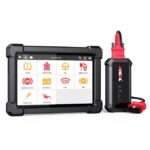Obd2 Eco Fuel saver devices claim to reduce fuel consumption by altering various engine parameters. These devices plug into your car’s OBD2 port and communicate with the Engine Control Unit (ECU). But do these devices actually work, or are they just another automotive gimmick? Let’s explore how these devices function and examine their potential impact on fuel economy.
How OBD2 Eco Fuel Devices Claim to Work
OBD2 eco fuel savers connect to your vehicle’s OBD2 port, a standardized diagnostic interface found in most modern cars. Once connected, the device accesses data from the ECU, the car’s computer, which manages engine functions. Manufacturers claim that these devices analyze driving patterns and adjust parameters like fuel injection timing, air-fuel ratio, and boost pressure to optimize fuel efficiency. The device supposedly learns your driving habits over time, further refining its adjustments for optimal savings.
Fuel Savings: Fact or Fiction?
While manufacturers often advertise significant fuel savings, typically up to 15%, independent testing often yields less impressive results. The actual fuel economy improvement, if any, can vary significantly depending on the vehicle, driving style, and the specific OBD2 eco fuel device. Some users report minor improvements, while others see no noticeable difference.
Potential Risks and Considerations
Although most OBD2 eco fuel savers are designed not to harm your vehicle, potential risks exist. Modifying engine parameters, even subtly, could potentially void your car’s warranty or negatively impact engine performance and longevity in the long run. It’s crucial to research the specific device you’re considering and consult with a qualified mechanic before installation. Remember, permanent changes to the ECU are possible with some devices. Unplugging the device may not completely revert these changes.
Installation and Compatibility
Most OBD2 eco fuel devices boast simple plug-and-play installation. Simply locate your car’s OBD2 port, typically under the dashboard on the driver’s side, and plug in the device. However, compatibility can vary. It’s essential to verify that the device is compatible with your vehicle’s make, model, and year before purchasing. Petrol and diesel engines often require different devices.
Conclusion: Proceed with Caution
OBD2 eco fuel savers offer a tempting proposition: improved fuel efficiency with minimal effort. However, the evidence supporting their effectiveness is often anecdotal and lacks rigorous scientific backing. While the potential for fuel savings exists, it’s crucial to manage expectations and approach these devices with a healthy dose of skepticism. Thorough research, consultation with a mechanic, and a realistic understanding of potential benefits and risks are essential before investing in an OBD2 eco fuel saver. Remember, consistent maintenance, sensible driving habits, and proper tire inflation often contribute more significantly to fuel economy than aftermarket devices.

